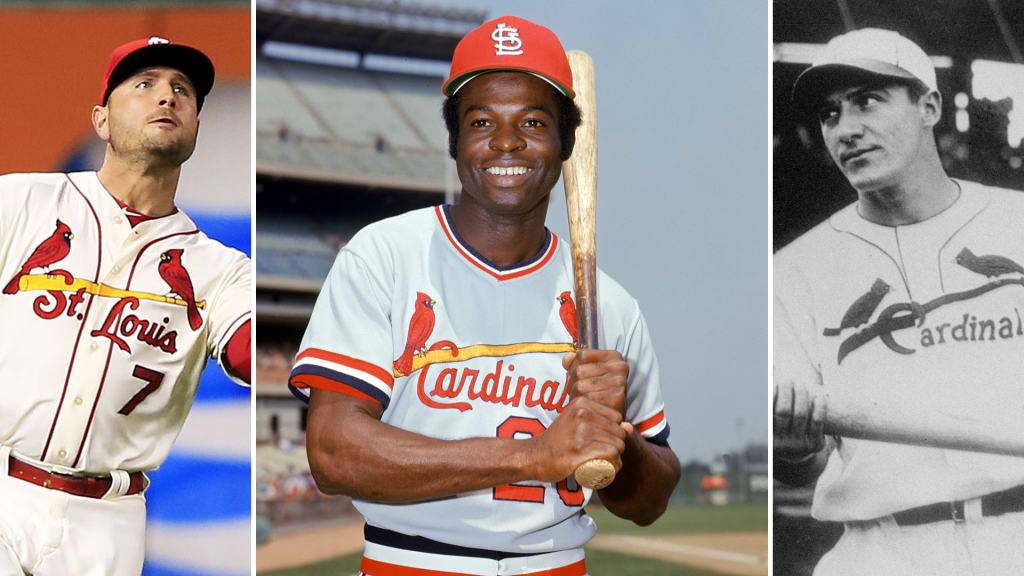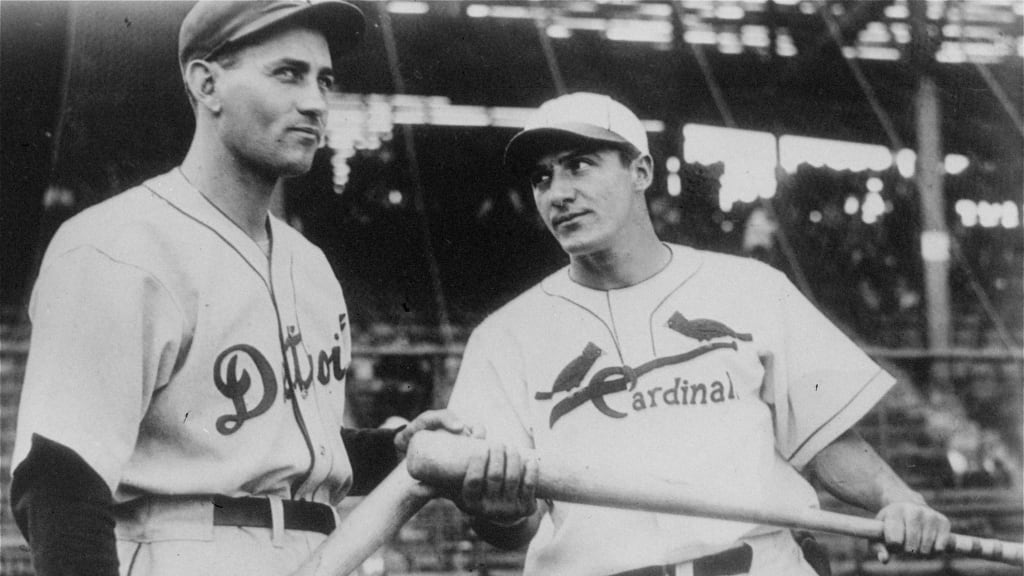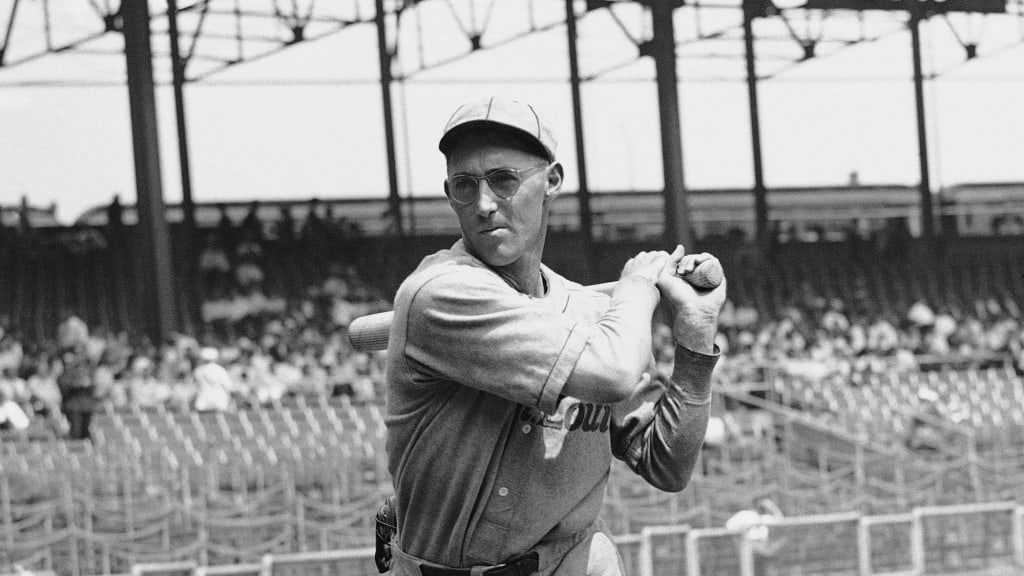
No one loves a good debate quite like baseball fans, and with that in mind, we asked each of our beat reporters to rank the top five players by position in the history of their franchise, based on their career while playing for that club. These rankings are for fun and debate purposes only … if you don’t agree with the order, participate in the Twitter poll to vote for your favorite at this position.
Here is Anne Rogers’ ranking of the Top 5 left fielders in Cardinals history. Next week: Center fielders.
Note: For this project, we’re ranking multi-position players at just one position, so Stan Musial will be ranked with the right fielders.
1) Lou Brock, 1964-79
Key fact: Led the National League in stolen bases for four straight seasons (1966-69) and led all of MLB in steals for another four straight seasons (1971-74)
On June 15, 1964, the Cardinals traded 20-game winner Ernie Broglio and two others to the Cubs for a package of three players that included Brock. Today, one side considers the trade the best in club history, while the other has fans still shaking their heads.
Brock, who had his No. 20 retired in 1979 and was inducted into the National Baseball Hall of Fame in '85, provided the foot power for three NL pennant winners and two World Series titles. After '64, Brock didn’t steal fewer than 50 bases for the next 12 years. The six-time All-Star became a student of the steal. In 16 years with the Cardinals, he stole 888 bases, hit .297 and accumulated 41.8 Wins Above Replacement, per Baseball-Reference.
At 35 years old in 1974, Brock was an unlikely candidate to break Maury Wills’ MLB record. Wills' mark of 104 stolen bases, set in '62, was 30 more than Brock’s personal best of 74, achieved in 1966. But at the All-Star break, Brock had 60 steals, and he passed his previous best with his 75th steal on Aug. 6. And on Sept. 10 at Busch Stadium, Brock tied Wills’ record when he stole second in the first inning and broke it when he swiped second in the seventh.
Brock ended the 1974 season with 118 stolen bases, which stood as the single season record until Rickey Henderson stole 130 seven years later. Henderson broke Brock’s MLB-best 938 career steals, too, but Brock is still second on the all-time list.
While Brock is known for his steals, he was far from a one-dimensional player -- a title he feared when the Cards tagged him to be their Wills. Brock wanted to be a well-rounded and complete player.
In 1967, Brock became the first player to hit 20 homers and steal 50 bases in a single season. He hit better than .300 eight times as a Cardinal, including a .304 average his final season -- he played 120 games, stole 21 bases and reached 3,000 hits at age 40. Brock led the Majors in runs scored twice, and in '67, he also led the Majors in doubles (46) and triples (14). He finished in the top 10 of NL MVP Award voting five times, including a runner-up finish in '74. He was at his best in the postseason, hitting .391 -- second only to Pepper Martin (.418) in franchise history -- with 34 hits in 21 World Series games. He also stole a record 14 bases in three World Series.
2) Joe Medwick, 1932-40, 1947-48
Key fact: Won the Triple Crown in 1937, something no other NL player has done since
Despite not having his number retired by the team, “Ducky” Medwick is one of the greatest Cardinals ever. He was inducted into the Hall of Fame in 1968 after a 17-year career and 11 years with St. Louis. He won the Triple Crown -- the second Cardinal to do so after Rogers Hornsby won it twice -- and NL MVP Award in '37, hitting .374 with 31 homers and 154 RBIs, and he was an All-Star in seven consecutive seasons.
From his debut in 1932 to when he was traded to Brooklyn in '40, Medwick averaged .333 with a .544 slugging percentage and a .915 OPS. His run from 1935-37 was incredible, when he hit .359/.396/.598 with a .994 OPS and 166 doubles, 72 homers and 418 RBIs. In 11 seasons with the Cards, Medwick accumulated 39.8 bWAR.
Medwick was a key part of a championship team, too. As a 22-year-old in the 1934 World Series, he went 11-for-29 with a homer and five RBIs against Detroit. A memorable figure of the Gashouse Gang, he had to be removed in Game 7 of the World Series after a hard slide into third base caused Tigers fans to throw garbage at him upon his return to left field.
Medwick wasn’t the same player when he returned to the Cards as a 35-year-old in 1947, but even with those final two seasons, his .335 average as a Cardinal ranks third all-time in franchise history (minimum 2,500 at-bats) behind Hornsby (.359) and Johnny Mize (.336), and Medwick’s 923 RBIs rank seventh. He also ranks fourth in doubles (377).

3) Matt Holliday, 2009-16
Key fact: Tied for second in franchise history with Ray Lankford with 102 game-winning RBIs
A key piece of the Cardinals’ success in the 2010s, Holliday hit .293/.380/.494 in 982 games with the Cardinals. He accumulated 23.1 bWAR in 7 1/2 seasons with St. Louis, made four All-Star teams, received MVP votes in four different seasons and won a Silver Slugger Award in 2010. He anchored four division titles, two NL pennants and the 2011 World Series -- he hit .435 in the NL Championship Series that October against Milwaukee, with one homer and five RBIs.
After coming to the Cardinals as part of a Trade Deadline deal in 2009, Holliday signed a seven-year, $120-million contract that offseason, which stood as the largest contract in franchise history at the time. Holliday lived up to the payday, from his power at the plate to his leadership role. During the length of Holliday’s contract, he slashed .277/.377/.486 and posted an .863 OPS. From 2010-14, Holliday was the only player in the Majors with at least 20 homers, 30 doubles and 75 RBIs each season.
Injuries limited Holliday’s offensive output during his final two seasons in St. Louis, but he still got a fitting farewell in his final games in 2016. The Cardinals activated him from the disabled list for the final series of the regular season, and he hit a pinch-hit home run in the first game, a pinch-hit RBI single in the second game and jogged out to left field in his final game, amid a standing ovation.
4) Chick Hafey, 1924-31
Key fact: Won the 1931 NL batting title with a .349 average
Hafey spent the first eight seasons of his 13-year career with the Cardinals and was a key part of two World Series titles. Known as one of the hardest-hitting right-handers at the time, Hafey’s NL batting title season in 1931 was his fifth consecutive season of hitting .329 or higher, and from '27-31, Hafey slugged .611 with 116 homers and 501 RBIs. His .326 average with the Cards ranks sixth on the club’s all-time list, and his .568 slugging percentage ranks fourth, behind Albert Pujols, Johnny Mize and Rogers Horsnby.
Inducted into the Hall of Fame in 1971, Hafey was also known for his outstanding speed and his powerful throwing arm. After all, he was originally signed as a pitcher in '23. And a fun fact: Hafey was one of the first players in the Majors to wear eyeglasses.

5) Vince Coleman, 1985-90
Key fact: Led the league in stolen bases every season he was in a Cardinals uniform
Coleman was as exciting as they come, debuting in 1985 and stealing an MLB-best 110 bases, while winning the NL Rookie of the Year Award and finishing 11th in the NL MVP Award voting. He was a key part of that Cards club that stole 314 bases and won 101 games to reach the postseason. Despite the tarp that prevented him from playing in that year's World Series, Coleman returned in '86 and stole 107 bases. In '87, he hit .269 in the NLCS against the Giants and he stole six bases in the Cards’ loss to the Twins in the World Series.
Coleman hit .265/.326/.339 with 106 doubles and 549 stolen bases in six seasons with St. Louis. He was a two-time All-Star and was elected to the Cardinals Hall of Fame in 2018.
Honorable mentions
• Tip O’Neill accumulated 25.4 bWAR from 1884-91 with St. Louis in the American Association, and he hit .344/.406/.490 in those seven years.
• Lonnie Smith helped spark the Cardinals to a World Series title in 1982, when he hit .307, led the league with 120 runs scored and finished second in MVP voting that year. In four seasons with St. Louis, Smith hit .292 with a .371 on-base percentage and 88 doubles.
• St. Louis native Bernard Gilkey hit .282/.354/.431 in six years with the Cardinals, and his best year came in 1993, when he hit .305 with 16 home runs and 70 RBIs. He played on some good Cards clubs, but he had a huge year for the Mets in ’96 after being traded.


